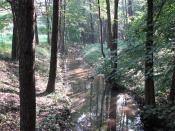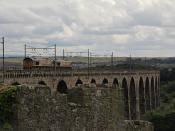Riparian inputs into aquatic habitats have been shown that they have a direct effect on the productivity of primary and higher order consumers. This dependence on the terrestrial environment for inputs into the system allows for a variety of interactions between the different trophic levels to take place (Wallace et al. 1999, as cited in L. E. England & A.D. Rosemond 2004). Riparian habitats have the ability to not only direct the degree of intensity of the physical, chemical and biological factors within the aquatic environment beneath them but can also influence the relationship one environment has with the other, as stated by Sweeney 1992 within the study by L.E. England & A.D. Rosemond 2004.
The River Continuum Concept (RCC), Vannote et al. 1980 as cited in L.E. England & A.D. Rosemond 2004, describes how food webs found at the head waters of aquatic ecosystems are mainly controlled through the inputs of detritus.
The importance of these detrital inputs reduces as it moves downstream and is increasingly depleted (Webster et al. 1990, as cited in L.E. England & A.D. Rosemond 2004). Specialised aquatic species that reside in headwater streams use especially designed feeding appendages to break up the organic detritus into small fragments. During this process of feeding small particles are transported downstream, as are the excretory products, it is in this downstream environment where other species, specialized to filter out particles from the water column, are located (Covich et al. 1999). This scenario is subject to the levels of light available to the aquatic environment, with high levels of canopy cover there is obviously going to be a higher level of vegetative input as well as a reduction in light intensity. These factors alone have an effect on the amount of organisms within the ecosystem and their ability to...


